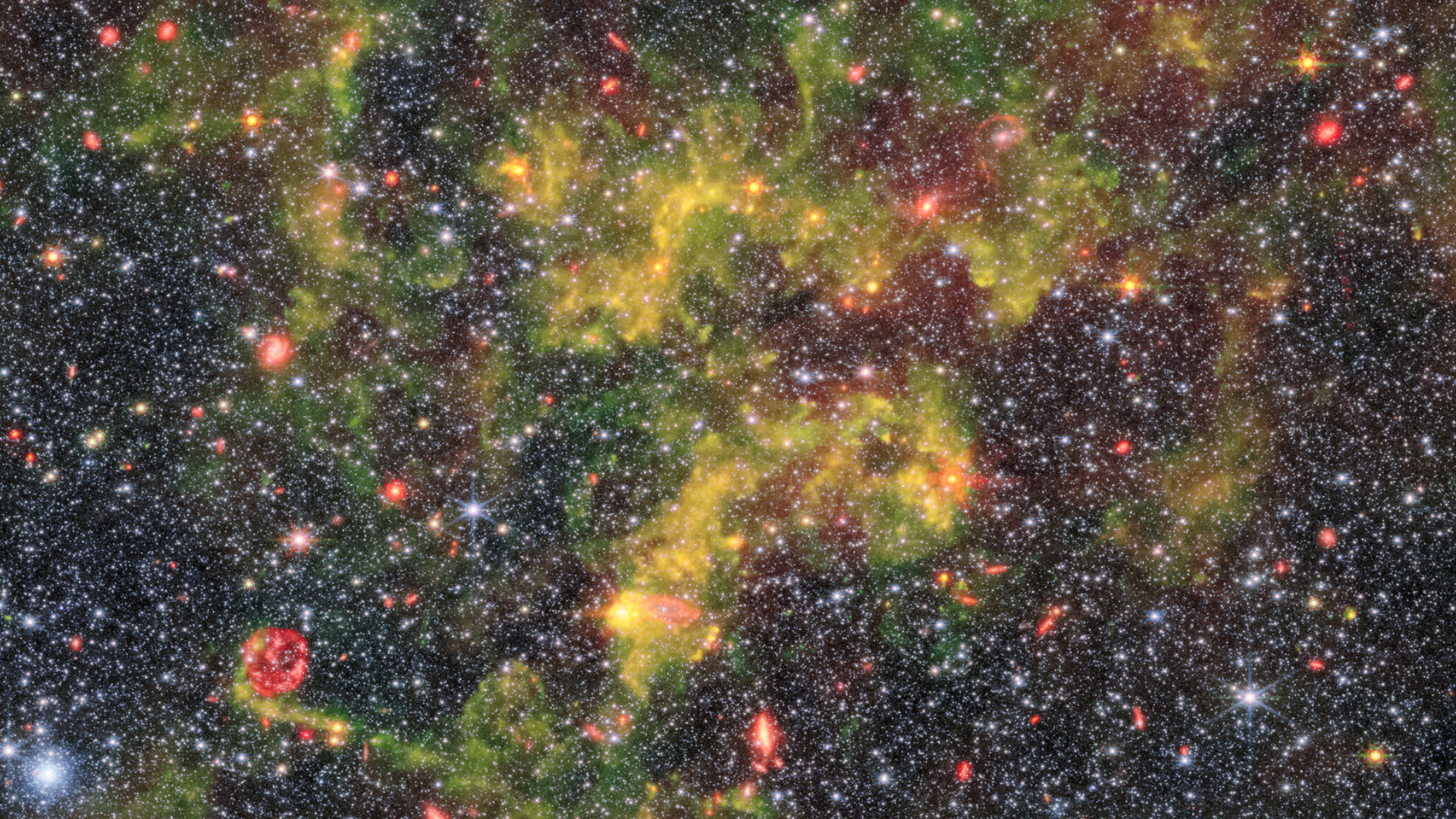
The James Webb Space Telescope (JWST) has imaged a galaxy neighboring the Milky Way in stunning detail.
Located around 1.5 million light-years away from Earth, the irregular-shaped galaxy, NGC 6822, is the Milky Way's closest galactic neighbor — barring some small satellite galaxies, such as the Large and Small Magellanic Clouds, that lie in its close orbit.
Created using the James Webb Space Telescope's Near-Infrared Camera (NIRCam) and Mid-Infrared Instrument (MIRI), the image shows the gas and dust of NGC 6822 glowing in green and gold while billowing across a dense field of stars. Bright galaxies of various shapes and sizes also punctuate the image.
This nearby galaxy is particularly interesting because it's what astronomers call "metal-poor," meaning it lacks elements heavier than hydrogen and helium, according to a European Space Agency (ESA) statement. For context, astronomers call all elements heavier than those two, which are the lightest elements, "metals."
Such a composition makes NGC 6822 a great proxy for studying galaxies in the early universe, which are too far away to see in detail. That's because early galaxies are also thought to have had low-metallicities. When galaxies and stars first began to form in the universe, space was populated by just hydrogen, helium and a tiny smattering of heavier elements. Thus the first stars were similarly metal-poor.
Related: James Webb Space Telescope spies giant cosmic question mark in deep space (photo)
Throughout their lifetimes, the first stars in our universe forged heavier elements in their cores via the nuclear fusion of hydrogen and helium. When these stars exhausted that fusion fuel, they ended their lives in supernova explosions which dispersed the heavy elements all across their cosmic vicinities.
These elements were then integrated into interstellar clouds of gas and dust that eventually collapsed to birth new stars. This next generation of stars was thus more metal-rich. That same process repeated with the third generation of stars becoming even more enriched with metals. In fact, the sun is an example of one of these third-generation metal-rich stars.
The low-metallicity galaxy, NGC 6822, thus offers astronomers a chance to observe how the evolution of stars and interstellar gas and dust clouds proceeded in the metal-poor environments of the early universe.
Other stars in the Milky Way range in metalicity, with the most metal-rich stars found in its central bulge and the more metal-poor stars mostly located in its disk and spiral arms.
NGC 6822 is no stranger to astronomers.
The irregular galaxy is a known point of interest because it doesn't fit the template of galaxies with well-defined shapes. It doesn't quite resemble a spiral galaxy, such as the Milky Way, or an elliptical galaxy.
First discovered by American astronomer E. E. Barnard in 1884, it was even initially misidentified as an "exceedingly faint nebula." This confusion regarding NGC 6822 continued for several decades, with disagreements raging about its size and its brightness. These disparities arose from the fact astronomers had yet to account for how different objects would appear to different telescopes.
The debate was settled in 1925, when Edwin Hubble confirmed the existence of astronomical objects beyond the limits of the Milky Way. Hubble himself acknowledged the importance of NGC 6822 in this revelation, writing: "N.G.C. 6822, [was] the first object definitely assigned to a region outside the galactic system."
Until the 2000s, the most definitive work regarding NGC 6822 was a 1966 paper by Susan Kayser, who was the first woman to receive a Ph.D. in astronomy from Caltech.
Now, the JWST is building on the work of Hubble and Kayser, strengthening our knowledge of our metal-poor next-door neighbor while allowing us to marvel at its beauty.







